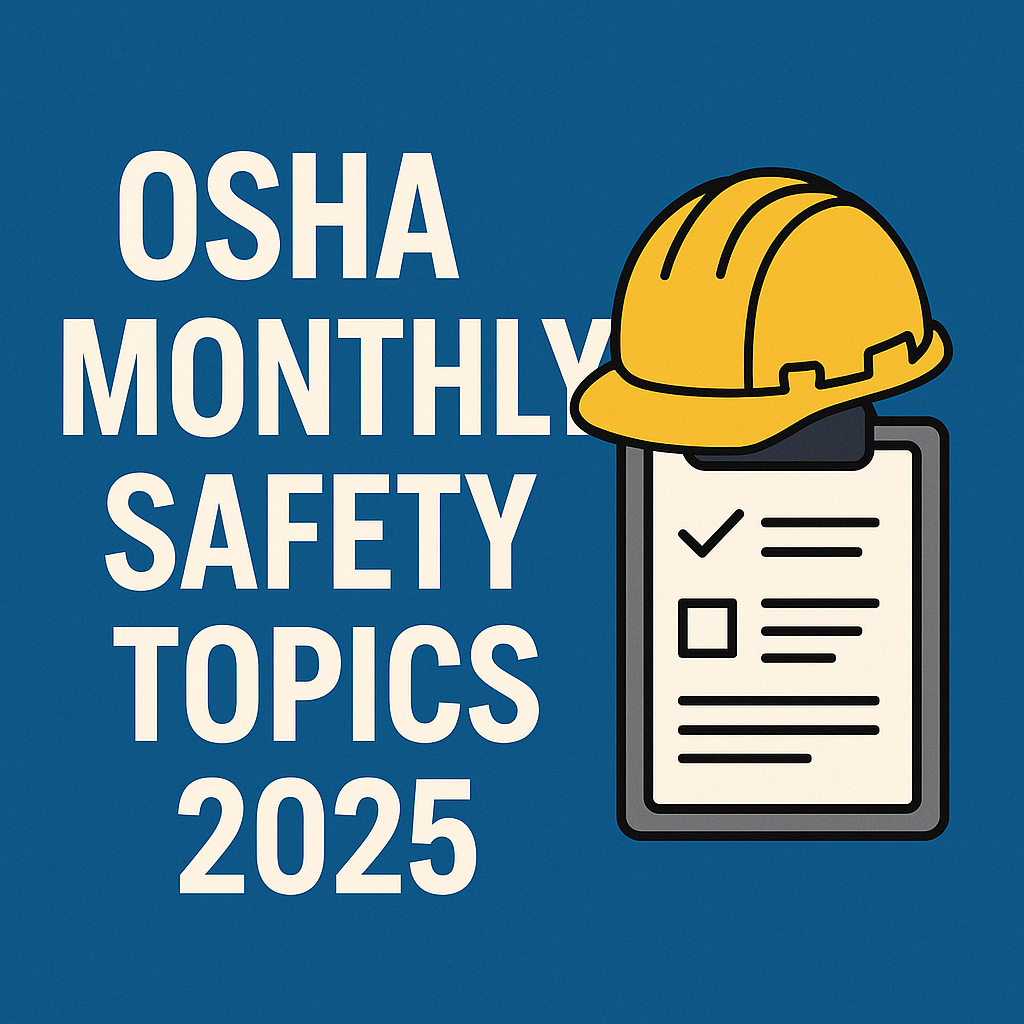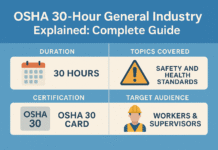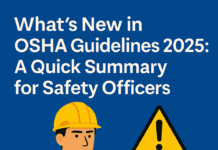
OSHA Monthly Safety Topics 2025
Why Monthly Safety Topics Matter
Let’s be honest—talking about safety once a year isn’t enough. Regular reminders help reinforce safe behavior and keep hazards top of mind. That’s where OSHA monthly safety topics come in. They break down key issues into bite-sized, manageable focus areas that teams can tackle every month.
The Role of OSHA in Workplace Safety
OSHA (Occupational Safety and Health Administration) sets and enforces standards to ensure safe working conditions. Their monthly topics aren’t just “suggestions”—they’re rooted in real trends, risks, and injuries seen on worksites. These topics help employers stay compliant and protect their teams.
How to Use OSHA Monthly Topics Effectively
Toolbox Talks vs Safety Meetings
Toolbox talks are short, informal, and focused—ideal for quick daily check-ins. Safety meetings are more formal and detailed. OSHA topics can be used in both formats depending on your company’s setup.
Getting Employee Engagement
Want to avoid bored faces and blank stares? Make the topics interactive. Use quizzes, videos, or real-life stories from your site. When employees relate, they retain.
Scheduling & Consistency Tips
Put safety meetings on the calendar—same day, same time, every month. Consistency builds a culture. Assign a safety champion to lead sessions and follow up on action items.
Monthly OSHA Topics Breakdown for 2025
January – Slips, Trips, and Falls Prevention
Start the year off strong by tackling one of the top causes of workplace injuries. Discuss:
- How to spot slip hazards
- Proper footwear
- Reporting near-misses
Use icy weather as a real-world example to drive the point home.
February – Fire Safety and Emergency Response
February is a great time to review fire drills and extinguisher training. Topics include:
- Evacuation procedures
- Alarm system checks
- Fire extinguisher types and how to use them
Bonus tip: Review your site’s emergency numbers and display them clearly.
March – Ergonomics and Repetitive Stress Injuries
Whether in construction or office work, bad posture hurts. Cover:
- Proper lifting techniques
- Desk setup tips
- Break reminders
Use demos and encourage self-assessments.
April – Distracted Driving & Road Safety
With National Distracted Driving Awareness Month, April is perfect to:
- Talk about texting while driving
- Vehicle inspections
- Defensive driving tips
Fleet drivers and mobile teams will benefit the most here.
May – Heat Stress and Hydration
Before summer peaks, prepare for high temps. Train your team on:
- Symptoms of heat exhaustion vs heat stroke
- Drinking enough water
- Using cooling PPE or vests
Use OSHA’s heat index app as a daily guide.
June – National Safety Month: All-Round Safety Awareness
Celebrate safety with a theme each week:
- Week 1: Hazard Recognition
- Week 2: Safety Culture
- Week 3: Incident Response
- Week 4: Wellness & Mental Health
Mix in competitions, quizzes, or even small giveaways to boost involvement.
July – Electrical Safety Best Practices
July’s a great time to spotlight electrical hazards. Cover:
- Lockout/tagout for electrical systems
- Ground-fault protection
- Inspecting extension cords and tools
Real-life case studies work well here.
August – Hazard Communication (HAZCOM)
It’s time for SDS (Safety Data Sheet) and labeling refresher training:
- How to read a chemical label
- Where SDS sheets are stored
- PPE needed for handling chemicals
Tailor it to chemicals actually used on your site.
September – Personal Protective Equipment (PPE)
Back to basics! Remind your team:
- When and how to wear PPE
- Fit testing (especially for respirators)
- Maintenance and replacement
Bring in actual gear and have a PPE inspection session.
October – Lockout/Tagout (LOTO) Procedures
Before maintenance season kicks off:
- Demonstrate proper LOTO procedure
- Review energy sources (electrical, hydraulic, pneumatic)
- Share LOTO near-miss stories to highlight importance
November – Respiratory Protection and Air Quality
Cold and flu season = respiratory risk. Discuss:
- Fit testing and use of respirators
- Indoor air quality checks
- How to report breathing issues
Especially relevant for construction, painting, and confined space crews.
December – Winter Weather Safety & Mental Health
End the year by focusing on cold weather and psychological safety:
- Avoiding frostbite and hypothermia
- Safe driving in snow/ice
- Holiday stress management and mental wellness
This is the month to show that you care beyond the hard hat.
Tips for Conducting Monthly OSHA Safety Meetings
Keep It Short, Sweet, and Relevant
Nobody wants a lecture. Aim for 10-15 minutes and focus on actionable points.
Use Real-Life Scenarios
“What if” stories make people think. Share site-specific incidents (without naming names!).
Encourage Two-Way Communication
Ask open-ended questions. Reward input. Make safety a conversation, not a sermon.
Benefits of Using Monthly Topics in Your Safety Program
- Builds a consistent safety culture
- Keeps employees alert and informed
- Encourages proactive hazard identification
- Reduces incidents and injuries
- Ensures compliance with OSHA guidelines
Conclusion
Staying ahead of workplace hazards doesn’t require magic—just a solid plan, great communication, and consistency. By following these OSHA monthly safety topics in 2025, you’re not just ticking boxes. You’re investing in lives, productivity, and peace of mind.
So whether you’re a safety officer, supervisor, or business owner—start now. Your people deserve it.
OSHA and IOSH Officer Salary in Dubai
Check your OSHA Certificate is Original or Fake?
How To Become an OSHA Inspector in 5 Steps
OSHA Career Guide: Jobs, Salaries & Growth Opportunities (2025)
OSHA New Rules 2025: What Employers Must Know
FAQs
1. Are OSHA monthly topics mandatory?
No, but they’re strongly recommended to help keep your workplace compliant and hazard-free.
2. How long should a monthly safety meeting last?
Ideally, 10–15 minutes. Longer if paired with demonstrations or Q&A.
3. Where can I find OSHA topic templates?
Visit OSHA.gov or use mobile safety apps that offer ready-to-go templates.
4. Can I customize these topics for my industry?
Absolutely! Tailoring the discussion to your work environment increases relevance and impact.
5. What’s the best way to track participation?
Use sign-in sheets or a digital attendance log via mobile apps for easy documentation.
























